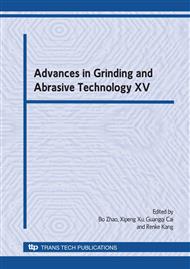p.461
p.467
p.472
p.477
p.482
p.487
p.492
p.497
p.504
Grinding of Nanostructured WC Coatings with Single Fibrous-Abrasive Wheel
Abstract:
The random nature of the abrasive geometries and their distribution in a grinding wheel results in high specific grinding energy and temperature rise, large grinding forces and large deflection in the grinding system. To overcome the shortcomings encountered in grinding, it is necessary to design a new grinding wheel that is structured in controlled abrasive geometries with preferred spatial positioning and orientation. This paper deals with an experimental research of single fibrous-abrasive grinding of a nanostructured WC/12Co Coating. Prepared by the laser cutting of polycrystalline diamond compact (PDC), the single fibrous-abrasive has the dimensions of 0.3×0.6×10mm. The paper reports the research findings on normal and tangential grinding forces in terms of depth of cut and feed rate and discusses the material removal mechanism of nanostructured WC/12Co Coating ground by fibrous abrasive.
Info:
Periodical:
Pages:
482-486
Citation:
Online since:
September 2009
Authors:
Price:
Сopyright:
© 2009 Trans Tech Publications Ltd. All Rights Reserved
Share:
Citation:


